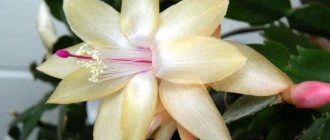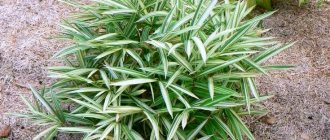Author's rating
Author of the article
Yakov Pavlovich
Professor, Head of the Department of Vegetable Growing
Articles written
153
Heather is a wild evergreen shrub that reaches 60-70 cm in height, has needle-like green leaves and blooms in original clusters of small bells. The plant can be wild or cultivated. Growing heather at home is a troublesome task; as the shrub develops in a pot, it becomes demanding. But if someone once grew this amazing plant in their home, then they remain a fan for life. Heather will be a spectacular decoration of any interior for months.
Pros and cons of growing heather at home
When growing heather at home, you may encounter nuances that have positive and negative sides.
The advantages include the following:
- Heather grown at home will give a natural, bright design to rooms, loggias or terraces.
- If the plant is grown at home, it guarantees flowering almost all year round - and evergreen bushes will decorate any interior.
- The flower looks great in original compositions with other indoor plants.
- Inflorescences with a subtle, delicate aroma, it will add a special charm to the atmosphere of the house.
The disadvantages include special care:
- Mandatory compliance with conditions under which the plant will be comfortable. Heather should be kept in a room at a certain temperature and humidity.
- It is necessary to properly water the flower and spray it.
- In order for the plant to always delight with its greenery and flowers, it needs to be renewed. After the heather flowering period, fertilizing is applied to its soil, then the bush is pruned. After this, next year, the plant will retain its attractiveness, splendor and aesthetic shape.
For gardeners, caring for your favorite plant will not be considered a minus, but will acquire the “rank” of special attention.
General characteristics
The plant is native to Africa and the Atlantic islands. Common heather is a small, but very branched bush in the ground part, on which a large number of creeping shoots develop with their tops raised above the ground.
Under natural conditions, it grows in areas with rather harsh conditions: on rocky soils, coniferous forest clearings, in swampy areas or in the tundra. The average size of wild bushes reaches 50-60 cm. The branches are covered with small narrow leaves that never fall off and give the crop a resemblance to conifers.
At the tops of the shoots there are densely arranged small flowers resembling bells in shape. The lilac-flowered species are the most common, but there are also pink, white, bright purple and lilac varieties that look particularly attractive when grown in close proximity to each other.
Flowering for most subspecies begins in August and can continue until Christmas. After flowering, fruits in the form of boxes remain on the bush. Recently, many new varieties have been developed whose buds are much larger than those of wild representatives of the species. They stay on the bushes longer and have a richer color. Some hybrids are adapted specifically for indoor growing, so caring for them at home is much easier. There is a variety in which the buds remain closed throughout the decorative period, so this flowering continues almost twice as long as in other varieties.
Recommended varieties
Professionals recommend choosing the following varieties for growing on your window:
Ordinary
Common heather reaches up to 50 cm. The bush branches strongly. The color of the stems is bright with a reddish tint. Abundant flowers do not fall off for a long time after flowering has ended. A variety with delicate flowers of pink and lilac tones.
Wintering
An interesting variety reaches half a meter in height. It has large flowers up to 2 cm each, the color is snow-white; with abundant flowering, the plant fills the space with delicate light purity and “reflects” sunlight.
Slim
Heather is considered one of the brightest and most beautiful among indoor varieties. Compact bushes do not grow higher than 40 cm, the foliage is soft green. During the flowering period there is an abundance of inflorescences. Their color can be purple, pink, red. The last shade is reminiscent of pomegranate clusters.
Mix
The original variety attracts attention. Its flowers can be of different shades (white, pink, purple). The lush bush grows up to 50 cm and captivates with its delicate greenery and abundant flowering.
Practical use
Heather flowers have unique honey-bearing properties that allow them to produce special nectar. Bees flock to it, helping the flower to multiply, while they themselves store the necessary elements for the winter to support life. The honey productivity of this plant reaches 200 kg per hectare. In Robert Louis Stevenson's famous ballad "Briar Honey", the main character chooses to die rather than reveal the secret of making the elixir of life to his enemy, made from Briar Honey. The best alcoholic drinks in Scotland and Norway - ales and strong beers - are made from Heather.
Heather flowers have extraordinary medicinal properties; they are harvested during the flowering period along with the tops of young shoots. The medicinal properties of this flower are recognized by medicine in many countries; medications made from this plant have no side effects and are used as sedatives, diuretics, wound healing and anti-inflammatory agents. They are successfully used to treat gastrointestinal tract, gastritis, cystitis. They have hemostatic properties and prevent the occurrence of malignant tumors. Baths with decoctions treat gout, arthritis, radiculitis and other joint diseases. Along with the beneficial properties mentioned above, they should not be used if you have low stomach acidity, a tendency to constipation, or individual intolerance.
Conditions of detention
Typically, a flower lives shorter indoors than in open soil. As a rule, up to 2-3 years. But if grown correctly, beautiful heather can bloom continuously.
Lighting, temperature and humidity
This plant requires certain conditions for good development in the apartment. Heather should be installed in places well lit by the sun, but the plant does not tolerate high temperatures. It should not be placed near heating devices, radiators, or stoves.
The temperature in the room during the flowering period should be cool, no higher than + 120C, in summer no more than +250C, in winter +8+120C. The plant also requires constant ventilation and spraying, especially on hot days. Heather needs a lot of moisture; dry air will negatively affect the flower.
See also Potted lilies: planting and care at home
Soil and pot volumes
It is important to remember that for planting the pot must be spacious and deep, larger than the length of the heather root. As the flower grows, it should be transplanted into a larger pot. Large flowerpots and long boxes are ideal, where you can easily create bright compositions of heather. The soil should be chosen in the form of sandy, acidic or peaty substrates, humus - the plant is soil selective. Drainage is also necessary.
Preparing the soil for planting
The soil must be acidic, this is one of the most important requirements , and the rest is not so critical, although it is better to give preference to a mixture of humus, peat and sand with the addition of sawdust or pine needles. Also, shortly before planting, it is recommended to additionally oxidize the soil with a special liquid: for 10 liters of water we take 100 grams of apple cider vinegar or citric acid, you can use 50 grams of electrolyte for batteries.
Read also: How to raise laying hens at home
Before planting, carefully straighten the root system of each bush by hand so that the roots look outward and not inward - if this is not done, the heather will not be able to take root and will die. When planting, the root collar of the bush should be slightly higher than the ground, and lay drainage at the bottom of each hole. When planting in a pot, you need to take a container 5-6 cm wider than the rhizome and be sure to leave the “native” lump of earth on the roots. The ideal time for planting is from mid-April to early June.
If you decide to plant a flower with seeds, then remember that under indoor conditions, heather will bloom within two years. The seeds are sown on the surface of the ground and placed in a greenhouse (covered with film). In two to three weeks, seedlings will appear, which are transplanted into open ground, preferably in the spring, but it is also possible at the end of September. Plants that have just reached three years of age are pruned, being careful not to cut off the branches at the root.
Planting and caring for indoor heather
The flower should be planted in a pot in the warm season - in spring, early summer, or in September-October. Comfortable temperature for heather growth is +18+220C, it gives better adaptation and development of roots.
Preparing the soil and seedlings
Since the plant loves acidic soils, it is necessary to acidify the soil before planting and then once a year. A good soil mixture for planting is peat/coniferous soil/river sand in a ratio of 3/2/1. Next (before planting) the soil is watered with heated clean water.
Depth and landing rules
When planting a plant, it is worth remembering that the root system must be completely covered with soil. Otherwise, it may be damaged and the heather will die. During planting, the bottom of the pot is filled with appropriate substrate so that the roots have room to grow. Next, carefully place the planting material in the pot, while it is advisable not to disturb the root system (in the earth coma). Then add the required amount of soil and water it with water.
Expert opinion
Stanislav Pavlovich
Gardener with 17 years of experience and our expert
Ask a Question
Important! When planting, the top layer of soil is not compacted, as this can damage the roots, which will negatively affect the entire plant.
Watering and spraying
It is recommended to water the plant 1-2 times every 7 days, under the roots, without getting on the foliage, in order to avoid gray rot. In winter, watering is reduced to a minimum. For irrigation, water should be allowed to settle so that it is freed from chlorine and warms up. You can use melted water or clean rainwater. Also, the flower must be sprayed regularly.
Fertilize the flower
Fertilizing should be done at the time of flowering using the root method. Complex universal liquid formulations and mineral fertilizers for ornamental plants are ideal. To acidify the soil, use sulfur or spruce bark.
Trimming and shaping
The plant should be cared for immediately after flowering. To do this, faded shoots are cut off, leaving no more than a third of the length. This prolongs the life of the plant, stimulates the heather to bloom again, making it more lush and bushy. Fresh stems are removed to create a neat bush shape. Woody stems will produce young shoots.
Wintering
For a safe wintering, the heather should be placed in a cool room with a temperature no higher than +80C. At the same time, you should monitor the condition of the soil and prevent it from drying out. Water the flower rarely and little. Insulated loggias and winter gardens are ideal.
Transfer
In order for the heather to feel as comfortable as possible, it should be replanted after a year. The renewed soil will give the plant everything it needs for growth and nutrition. Transplantation is carried out by transferring the plant with a lump of earth at the root; this minimally injures the flower.
Expert opinion
Stanislav Pavlovich
Gardener with 17 years of experience and our expert
Ask a Question
Important! It is better to replant the bush in the spring, when the plant is not yet blooming. It is better not to touch old plants.
Plants that look like heather
Heather is often confused with other similar plants. Most often there are two of them - Erica and Dabecia. Let's talk about them in a little more detail.
Erika
In fairness, it is worth noting that Erica is indeed a very close relative of heather. She can be called his “cousin.” Both plants belong to the Ericaceae family.
Caring for Erica is similar to caring for heather. Its inflorescences are painted in various shades of pink - from salmon to fuchsia, or white. The flowering times of these two relatives may overlap, so distinguishing one plant from another is not always easy.
The easiest way to identify Erica is by its leaves. They are glossy, similar to spruce needles, while those of heather are rather matte and more reminiscent of thuja or juniper leaves.
- Erica – growing an unpretentious beauty
Everything you wanted to know about planting, care and propagation of Erica.
Dabecia
Dabecia is another representative of the Heather family. It is difficult to confuse it with other “relatives”: its inflorescences are single, and not collected in racemes, like those of Erica and heather. Therefore, you can often mistake it for a “cousin” of these plants, but only from afar.
By the way, the popular name for dabecia is Irish heather. And she received it in honor of the Irish saint - Dabeok.
Dabecia grows in the southwestern part of Europe. Dabecia Cantabria is most often grown on the continent, and its “sister”, Dabecia Azores, is “registered” in the Azores.
Dabecia blooms at the end of summer - beginning of September.
Diseases and pests of crops
Heather is not very susceptible to diseases at home, however, some parasites and diseases can harm the plant if measures are not taken in time:
- With excessive watering, when water stagnates at the roots, gray rot occurs. It manifests itself in the form of white spots and growths on the heather, and the foliage begins to wither. Topaz or Fundazol will help cope with the problem. Experts recommend spraying the plant with a weak solution of copper sulfate for prevention.
- The nuisance of rust, which manifests itself as characteristic spots on the leaves, is eliminated by Topaz.
- Widespread powdery mildew “rewards” the plant with white and brown spots. It is also easy to overcome with the help of Fundazol.
- Pests in the form of spider mites are removed using Aktar and Actellik, and aphids are removed using Inta-Vira.
See also: The nuances of planting and caring for barberry bushes in open ground
Trouble can occur when infected with a virus, when the plant slows down, branches bend, and flowers and foliage change color. In this case, the heather cannot be saved, and to prevent it from infecting other flowers, it should be disposed of (burned).
Possible difficulties during cultivation
Unlike wild heather, cultivated heather requires a special approach. For its normal growth and development, certain conditions are required: cool air, moderate humidity and diffused light. To prevent the plant from getting sick, it is necessary to ensure that moisture does not stagnate in the pot and that there is a sufficient concentration of nutrients. It is also necessary to carry out formative pruning, cutting young shoots by a third.
Heather, despite its capriciousness to growing conditions, is increasingly attracting the attention of floriculture lovers. It is also used for interior decoration, loggias, and balconies; healing infusions and decoctions are prepared on its basis against insomnia, cancer, bladder and kidney diseases. Even novice plant growers can grow heather if they follow basic planting and care recommendations.
Features of reproduction
The plant can be grown from seeds, cuttings, or by dividing the root. Each method has its own characteristics. For home growing, a more suitable option is from seeds. Germination is excellent, up to 90%.
Seed method
This method is suitable for any season. The landing sequence is carried out in stages:
- Soil is laid out in a spacious container for drainage;
- water with warm water;
- loosen the soil;
- pour out seeds;
- add a layer of river sand (3 cm thick) and lightly water it.
The container is covered with film or glass, then placed in a warm and well-lit place. Shoots will appear in 3-4 weeks. During this time, the soil must be sprayed and ventilated to avoid drying out. Next, it will be very useful to take the seedlings out (for several hours) for “hardening” - on the balcony, terrace. Flowers are transplanted into pots for 8-10 months, when a strong root system is formed.
Important! For cuttings, you should choose the upper parts of heather. Experts do not recommend using flowering branches.
Cuttings
For this method, you can purchase ready-made cuttings for planting in the store, or prepare them yourself step by step:
- cut off a strong shoot 10 cm long with vegetative buds, preferably annual seedlings;
- place it in a container with a substrate of sand and peat;
- Root formation will take 4-5 weeks.
During cuttings, the container is regularly watered and the temperature is provided at +15+220C. The transplant to a permanent place should be done in a month. During this period, the roots will become strong.
Expert opinion
Stanislav Pavlovich
Gardener with 17 years of experience and our expert
Ask a Question
Important! Cuttings provide heather with more stable immunity to diseases and pests.
By dividing the rhizome
The plant can also be propagated by dividing the rhizome. It's simple and fast. The most suitable time for work is the beginning of autumn. In advance (3-4 weeks in advance), peat should be added to the root so that at the time of transplanting it, together with the neck, is completely immersed in the soil by 05-08 mm. This promotes rapid growth of the root system. The heather is dug up with a lump of earth, and the roots are carefully cut into equal parts. At the same time, they try to injure the heather as little as possible. Then the parts are planted in pots, watered and fed.
How to care after planting?
Heather is considered an unpretentious plant, but there are still some nuances:
- Loves fresh air, but does not tolerate drafts
- A houseplant needs to be fertilized more often than a garden plant. To do this, use Kemira Universal or a special fertilizer for azaleas. To feed, the product can be diluted in water or simply sprinkled on top of damp soil, sprinkled with a little mulch. The plant more often suffers from overfeeding the soil than from its poverty.
- Periodic mulching of the roots has a beneficial effect on the plant, since its roots are sometimes located above ground level. For this you can use bark, shavings and sawdust.
- Avoid watering with tap water, which contains too much lime and chlorine.
- Be sure to remove dried twigs and leaves
It is better to water once a week with rain or melt water ; you can also settle the water in containers before watering. Add acid to the water periodically. Watering is done at the root, trying not to get on the ground part - the plant can be affected by gray rot, while trying not to allow the top layer of soil, which mainly nourishes the bush, to dry out.
Heather bush in landscape design
Reproduction is carried out by seeds, dividing the bush and layering. To divide the bush in the spring, having dug up the bush, carefully divide it into two or three parts, preserving the earthen lump on the roots, and replant it in a new place. When propagating by layering, sprinkle large shoots with soil to a depth of 10 cm. Moisten the hill frequently so that roots germinate faster. When the rope takes root, cut it off from the mother bush and replant.
The use of heather in folk medicine
In addition to decorative qualities (beautiful flowers, delicate greenery), heather also has medicinal properties, which are used in cosmetology and medicine. Infusions and decoctions of heather have anti-inflammatory, antibacterial properties and are effective against colds. In folk medicine, the plant is widely used in the treatment of cystitis, gout, liver and gall bladder.
Heather after flowering
In warm areas, heather overwinters without shelter, but if you experience frosty winters, and even without snow, then it is better to play it safe and prepare the heather for wintering. To do this, after the onset of cold weather, spread peat around the heather bushes, and cover the bushes themselves with spruce branches, which will prevent them from freezing in winter, and in early spring will protect them from sunburn. Remove the cover from the heather in April.











